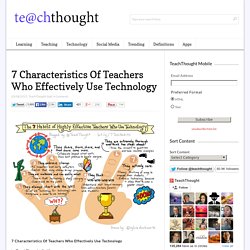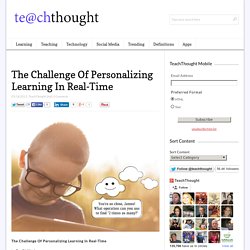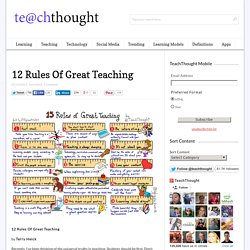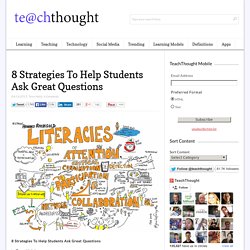

3 Simple Strategies To Integrate Technology Into Any Lesson. Creating Curriculum for Today’s Learners by Sandra L.

Love, Ed.D. The content of this article has been adjusted per the author’s original submission to clarify any confusion that might arise. In today’s classroom, we have moved beyond teaching reading, writing and mathematics through rote memorization. We must push students to dig deeper and ask clear, thoughtful questions so they build the critical thinking skills essential for success in school, college and life. While technology is an important part of the education equation, it doesn’t tell the whole story. 7 Characteristics Of Teachers Who Effectively Use Technology. 7 Characteristics Of Teachers Who Effectively Use Technology by TeachThought Staff Ed note: This post has been updated with an updated visual from Sylvia Duckworth, who took our graphic from alwaysprepped.com (now getalma) post and created the above visual.

It is also sporting a new title, as the “habits of” is a trademarked term. As such, the new graphic and phrasing appears below. GLOBAL BU on Twitter: "Technology-driven Education: Good #infographic on the Future of #Education! #edtech #DataScience #Innovation #BigData. David Geurin sur Twitter : "ICYMI: What do you want leaders to do with technology? via @gcouros #edchat #edtech... The Big Picture Of Education Technology: The Padagogy Wheel. The Big Picture Of Education Technology: The Padagogy Wheel.

44 Diverse Tools To Publish Student Work. 44 Diverse Tools To Publish Student Work by TeachThought Staff Educators are often admonished to design work that “leaves the classroom.”

Changing What We Teach. Changing What We Teach: Shifting From A Curriculum Of Insecurity To A Curriculum Of Wisdom by Terry Heick Increasingly, the idea of computer coding is being pushed to the forefront of “things.”

In movies, on the news, and other digital avatars of ourselves, coders are increasingly here. A Quick Summary Of The Theory Of Learning Curves - A Quick Summary Of The Theory Of Learning Curves by Steve Wheeler, Associate Professor, Plymouth Institute of Education This is number 9 in my series on learning theories.

The Challenge Of Personalizing Learning In Real-Time. The Challenge Of Personalizing Learning In Real-Time by Dr.

Philip Lanoue The conversation on the need to use student achievement data in education is fast-tracking its importance in today’s classrooms. But with so much data now directed at school leaders, teachers and students – how do you make sense of it all? First and foremost, it is imperative that every data point has a face – it is not about the number but about students and their performance. 12 Rules Of Great Teaching - 12 Rules Of Great Teaching by Terry Heick Recently, I’ve been thinking of the universal truths in teaching.

249 Bloom's Taxonomy Verbs For Critical Thinking. Bloom’s Taxonomy’s verbs–also know as power verbs or thinking verbs–are extraordinarily powerful instructional planning tools.

In fact, next to the concept of backwards-design and power standards, they are likely the most useful tool a teacher-as-learning-designer has access to. Why? They can be used for curriculum mapping, assessment design, lesson planning, personalizing and differentiating learning, and almost any other “thing” a teacher–or student–has to do.
8 Strategies To Help Students Ask Great Questions. 8 Strategies To Help Students Ask Great Questions by Terry Heick Questions can be extraordinary learning tools.

A good question can open minds, shift paradigms, and force the uncomfortable but transformational cognitive dissonance that can help create thinkers. In education, we tend to value a student’s ability to answer our questions. 21 Simple Ideas To Improve Student Motivation. 21 Simple Ideas To Improve Student Motivation by TeachThought Staff The best lessons, books, and materials in the world won’t get students excited about learning and willing to work hard if they’re not motivated.
Motivation, both intrinsic and extrinsic, is a key factor in the success of students at all stages of their education, and teachers can play a pivotal role in providing and encouraging that motivation in their students. 10 Characteristics Of A Highly Effective Learning Environment. 10 Characteristics Of A Highly Effective Learning Environment.
30 Habits Of Highly Effective Teachers. Editor’s Note: We often look at the qualities and characteristics of good teaching and learning, including the recent following pieces: How A Good Teacher Becomes Great What You Owe Your Students Ten Secrets To Surviving As A Teacher The Characteristics Of A Highly Effective Learning Environment. 10 Conditions For Self-Sustaining Learning In The Classroom.
10 Conditions For Self-Sustaining Learning In The Classroom by Grant Wiggins, Authentic Education. Where Good Ideas Come From & How Your Classroom Can Respond. Where Good Ideas Come From & How Your Classroom Can Respond The source for innovative or creative thinking is as much as mystery as that of curiosity or particular genius. 10 Team-Building Games That Promote Collaborative Critical Thinking. 10 Ways Teacher Planning Should Adjust To The Google Generation. 10 Ways Teacher Planning Should Adjust To The Google Generation. Hybrid BYOD and 1:1 Program Supports Blended Learning. 21st-Century Libraries: The Learning Commons. Professional Development - Miss D the Teacher. 12 Things Kids Want from Their Teachers. A Constructivist Approach to Teaching & Learning.
Let’s say the learning goal is to learn how to recognize main idea from details. An old-school classroom might provide the children with worksheets and multiple choice answers after a whole group lesson on the overhead with the teacher presenting the information. Technology, Writing, and Feedback. Critical Thinking: A Necessary Skill in the Age of Spin. Don't Quit: 5 Strategies for Recovering After Your Worst Day Teaching. Ice crystallized on the windshield, then a tire burst on the way to school, making you late. BTEC ICT Unit 1, Lesson 5 Digital Literacy. Managing Time and Behavior in the Classroom. When someone mentions behavior management, our first thought may be about controlling students or stopping them from performing inappropriate behaviors. Lessons Worth Sharing.
Creative Problem Solving and Decision Making. Explore complex, multi-actor systems in which one factor influences all other factors. For instance, how innovative energy technologies merge into the existing energy system, or how new health technologies, medicines, treatments and screening technologies in development impact current processes. Armed with this information, learn to decide whether they should be further developed, consider possible negative results and weigh associated costs.
There are multiple ways to make decisions, but one option proven to be very useful is the analytical approach-a methodology for making the problem explicit and rationalising the different potential solutions. Infographic: The Flipped Classroom. Differentiation - Miss D the Teacher. Hands-Off Teaching Cultivates Metacognition.